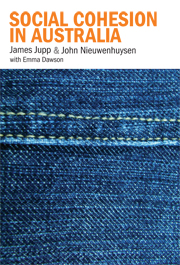Book contents
- Frontmatter
- Contents
- Foreword
- List of contributors
- List of tables
- Acknowledgments
- Introduction
- PART I DEFINING, MEASURING AND SEEKING SOCIAL COHESION
- PART II THE DYNAMICS OF SOCIAL COHESION
- 5 The landmark of Cronulla
- 6 Policing the other: Lebanese young people in a climate of conflict
- 7 Religious resurgence and diversity and social cohesion in Australia
- 8 Family and nation: the Indigenous/non-Indigenous relationship
- 9 Social cohesion and cultural fragility: a paradox of Indigenous rapports with Eurasian Australia
- 10 Educational attainments, inter-ethnic marriage and social cohesion
- PART III INFLUENCES AND RESPONSES IN SEARCHING FOR SOCIAL COHESION
- References
- Index
8 - Family and nation: the Indigenous/non-Indigenous relationship
Published online by Cambridge University Press: 22 September 2009
- Frontmatter
- Contents
- Foreword
- List of contributors
- List of tables
- Acknowledgments
- Introduction
- PART I DEFINING, MEASURING AND SEEKING SOCIAL COHESION
- PART II THE DYNAMICS OF SOCIAL COHESION
- 5 The landmark of Cronulla
- 6 Policing the other: Lebanese young people in a climate of conflict
- 7 Religious resurgence and diversity and social cohesion in Australia
- 8 Family and nation: the Indigenous/non-Indigenous relationship
- 9 Social cohesion and cultural fragility: a paradox of Indigenous rapports with Eurasian Australia
- 10 Educational attainments, inter-ethnic marriage and social cohesion
- PART III INFLUENCES AND RESPONSES IN SEARCHING FOR SOCIAL COHESION
- References
- Index
Summary
Historian John Hirst has recently suggested that ‘the marrying and partnering of people of all sorts across all boundaries is the greatest unifying force in Australia’ (Hirst 2006: 313). There has been a steady rise in the proportion of couples that identify themselves as ‘Indigenous’ in Australia's Census and that include a non-Indigenous partner, from 46 per cent in 1986 to 69 per cent in 2001 (Peterson & Taylor 2003: 111). Are these couples promoting Indigenous–non-Indigenous unification? Mathematics encourages doubt. Because the Indigenous proportion of Australia's population is small (just over 2 per cent) it does not take many non-Indigenous people marrying Indigenous Australians to give rise to this high proportion of ‘mixed’ couples. Less than 2 percent of the marrying non-Aborigines at any time are needed to choose Indigenous partners to continue the high proportion of mixed couples recorded in 2001. Most Australians could be racially prejudiced against intermarriage without affecting the rising intermarriage rates that the Census has recorded.
Numbers aside, what a poor analogy for the nation is the home! People who want to coexist within the one nation need not be attracted to the idea of sharing domestic space. A national polity is a far more impersonal social space than a kinship network or a household; it is therefore a more robust vehicle for social cohesion.
- Type
- Chapter
- Information
- Social Cohesion in Australia , pp. 90 - 102Publisher: Cambridge University PressPrint publication year: 2007
- 1
- Cited by

